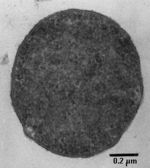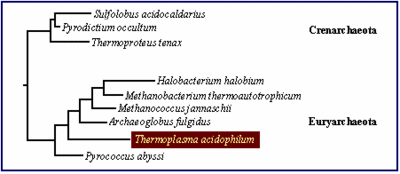Thermoplasma acidophilum: Difference between revisions
| Line 21: | Line 21: | ||
“Thermoplasma ''acidophilum'' is a thermophilic heterotrophic prokaryote growing at 55-60°C and pH 0.5-4, It is among the most acidophilic organisms known.” It is found and first isolated from self-heating coal refuse piles and solfatara fields. | “Thermoplasma ''acidophilum'' is a thermophilic heterotrophic prokaryote growing at 55-60°C and pH 0.5-4, It is among the most acidophilic organisms known.” (2) It is found and first isolated from self-heating coal refuse piles and solfatara fields. (3) | ||
“Microbial physiologists and structural biologists have long been fascinated by the ability of this microorganism to grow at high temperatures and low pH without the structural protection of a conventional cell wall”, “our interest in protein folding and degradation led us to seek a more complete representation of the proteins involved in these pathways by determining the genome sequence of this organism.” | “Microbial physiologists and structural biologists have long been fascinated by the ability of this microorganism to grow at high temperatures and low pH without the structural protection of a conventional cell wall”, “our interest in protein folding and degradation led us to seek a more complete representation of the proteins involved in these pathways by determining the genome sequence of this organism.”(3) | ||
==Genome structure== | ==Genome structure== | ||
Revision as of 20:39, 25 May 2007
A Microbial Biorealm page on the genus Thermoplasma acidophilum
Classification
Higher order taxa
Cellular organisms;Archaea; Euryarchaeota; Thermoplasmata; Thermoplasmatales; Thermoplasmataceae; Thermoplasma acidophilum (1)
Genus
Thermoplasma acidophilum
|
NCBI: Taxonomy |
Description and significance
“Thermoplasma acidophilum is a thermophilic heterotrophic prokaryote growing at 55-60°C and pH 0.5-4, It is among the most acidophilic organisms known.” (2) It is found and first isolated from self-heating coal refuse piles and solfatara fields. (3)
“Microbial physiologists and structural biologists have long been fascinated by the ability of this microorganism to grow at high temperatures and low pH without the structural protection of a conventional cell wall”, “our interest in protein folding and degradation led us to seek a more complete representation of the proteins involved in these pathways by determining the genome sequence of this organism.”(3)
Genome structure
Thermoplasma acidophilum’s genome contain special gene that allow this organism to survive in an environment similar in temperature and acidity to hot vinegar.
The genome is a single circular chromosome and was sequenced using a new strategy called "shotgun sequencing".It is one of the smallest microbial genomes ever sequenced.
“The genome of the organism consists of a single circular chromosome of 1.56 Mbp, containing 1509 ORFs. These identify Thermoplasma as a typical euryarchaeon with a substantial complement of bacterial-related genes. However, massive lateral gene transfer appears to have occurred between Thermoplasma and Sulfolobus solfataricus, a phylogenetically distant crenarchaeon inhabiting the same environment.”
Cell structure and metabolism
Species of the genus Thermoplasma lack rigid cell wall, but are only delimited by a plasma membrane, it is “devoid of protective outer shells (S-layer, cell wall), yet maintains a near-neutral cytosolic pH.”
“The lipid composition of T. acidophilum has been the subject of several investigations. This work has revealed the presence of large polar lipids, often glycosylated with glucose, mannose and gulose, phosphorylated, or both, forming phosphoglycolipids (Shimada et al, 2002). These unusual lipid compositions help the organism survive under these otherwise harsh conditions of temperature and pH by restructing proton flow across the membrane more efficiently than non-branched lipids (Baba et al, 2001)”
T. acidophilum is able to gain energy in several ways, either anaerobically by sulphur respiration or as a scavenger in extreme environment.
In Thermoplasma, “glucose degradation proceeds by a non-phosphorylated variant of the Entner–Doudoroff pathway, in which the first step is catalysed by glucose dehydrogenase. The acetyl-CoA produced in this pathway enters the oxidative tricarboxylic acid (TCA) cycle.” (the presence of enzyme require for this pathway had already been experimentally confirmed), the presence of glycolysis/gluconeogenesis has not yet been confirmed due to the absence of phosphofructokinase and fructose in this organism.
Ecology
Thermoplasma acidophilum plays an important role in the ecosystem, they act as scavenger of those extreme environment. “It has adapted to scavenging nutrients from the decomposition of organisms killed by the extreme acidity and requires yeast, bacterial or meat extract when grown in culture.”
The study and research on Thermoplasma acidophilum indicate that an aqueous extract of coal refuse will serve as a nutrient source this the first step leading to the discovery of the materials in coal refuse which support its growth. Indeed, the coal refuse material provides nutrients for the growth of a wide variety of microorganisms and could be a source of new growth factors.
Pathology
None of the archaea organism include Thermoplasma acidophilum had known to cause pathogen to human being.
Application to Biotechnology
“The 20S proteasome from T. acidophilum caught scientist attention recently because it's proteolytic mechanism is common between the archaebacterial and the eukaryotic forms of the enzyme which is clinically relavent.” (Wlodawer, 1995)
In higher eukaryotes, proteasome is involved in housekeeping and protein level regulation. Further understand of chemical mechanism of this enzyme can help us to understand disease cause by the mutation of protesomes such as cystic fibrosis, Angelman's syndrome, Parkinson's disease and Liddle syndrome (Vu et al, 2000; Schwartz et al, 1999).
“Dysregulation of this enzymatic system may also play a role in tumor progression, drug resistance, and altered immune surveillance, making the proteasome an appropriate and novel therapeutic target in cancer.”
Current Research
1) “Large chunks of DNA which have been borrowed from other species of microbe and incorporated into the chromosome of acidophilum. The genes are believed to come from microbes and bacteria that share the same environmental niches, like the soil near hydrothermal sites.”
2) Ubiquitin found in the archaebacterium Thermoplasma acidophilum strongly suggests that ATP-ubiquitin-dependent proteolysis is a cellular function that developed early in evolution.
3) Tremendous amount of research had been made on 20S proteasome of T.acidophilum, because this enzyme is common in higher eukaryotic organism and can play an important role on medical research.
References
[1. Darland, G. , Brock, T. D. , Samsonoff, W. & Conti, S. F. A thermophilic acidophilic mycoplasm isolated from a coal refuse pile. Science 170, 1416–1418 ( 1970).
2. Segerer, A. & Stetter, K. O. in The Prokaryotes (eds Balows, A., Trüper, H. G., Dworkin, M., Harder, W. & Schleifer, K. H.) 712–718 (Springer, New York, 1992).
3. Gutsche, I. , Essen, L. O. & Baumeister, W. Group II chaperonins: New TRiC(k)s and Turns of a Protein Folding Machine. J. Mol. Biol. 293, 295– 312 (1999).
4. Voges, D. , Zwickl, P. & Baumeister, W. The 26S proteasome: A molecular machine designed for controlled proteolysis. Annu. Rev. Biochem. 68, 1015–1068 (1999).
5. Fleischmann, R. D. et al. Whole-genome random sequencing and assembly of Haemophilus influenzae Rd. Science 269, 496– 512 (1995).
6. Himmelreich, R. et al. Complete sequence analysis of the genome of the bacterium Mycoplasma pneumoniae. Nucleic Acids Res. 24, 4420–4449 (1996).
7. Yasuda, M. , Yamagishi, A. & Oshima, T. The plasmids found in isolates of the acidothermophilic archaebacterium Thermoplasma acidophilum. FEMS Microbiol. Lett. 128, 157–161 ( 1995). 8. Lopez, P. , Philippe, H. , Myllykallio, H. & Forterre, P. Identification of putative chromosomal origins of replication in Archaea. Mol. Microbiol. 32, 881– 891 (1999).
9. Ree, H. K. R. & Zimmermann, R. A. Organization and expression of the 16S, 23S and 5S ribosomal RNA genes from the archaebacterium Thermoplasma acidophilum. Nucleic Acids Res. 18, 4471–4478 (1990).
10. Budgen, N. & Danson, M. J. Metabolism of glucose via a modified Entner–Doudoroff pathway in the thermoacidophilic archaebacterium Thermoplasma acidophilum. FEBS Lett. 196, 207–210 (1986).
11. Searcy, D. G. & Whatley, F. R. Thermoplasma acidophilum: Glucose degradative pathways and respiratory activities. Syst. Appl. Microbiol. 5, 30–40 (1984).
12. Luebben, M. Cytochromes of archaeal electron transfer chains. Biochim. Biophys. Acta 1229, 1–22 ( 1995).
13. Klenk, H. P. et al. The complete genome sequence of the hyperthermophilic, sulphate-reducing archaeon Archaeoglobus fulgidus. Nature 390, 364–370 (1997).
14. Huang, C. J. & Barret, E. L. Sequence Analysis and Expression of the Salmonella typhimurium asr Operon Encoding Production of Hydrogen Sulfide from Sulfite. J. Bacteriol. 173, 1544–1553 (1991).
15. Rudolph, J. & Oesterhelt, D. Chemotaxis and phototaxis require a CheA histidine kinase in the archaeon Halobacterium salinarium. EMBO J. 14, 667–673 ( 1995).
16. Coles, M . et al. The solution structure of VAT-N reveals a 'missing link' in the evolution of complex enzymes from a simple beta alpha beta beta element. Curr. Biol. 9, 1158–1168 (1999).
17. Golbik, R. , Lupas, A. N. , Koretke, K. K. , Baumeister, W. & Peters, J. The janus face of the archaeal Cdc48/p97 homologue VAT: Protein folding versus unfolding. Biol. Chem. 380, 1049–1062 (1999).
18. Lupas, A. , Flanagan, J. M. , Tamura, T. & Baumeister, W. Self-compartmentalizing proteases. Trends Biochem. Sci. 22, 399–404 (1997).
19. Zwickl, P. , Ng, D. , Woo, K. M. , Klenk, H. P. & Goldberg, A. L. An archaebacterial ATPase, homologous to ATPases in the eukaryotic 26 S proteasome, activates protein breakdown by 20 S proteasomes. J. Biol. Chem. 274, 26008– 26014 (1999).
20. Tamura, N. , Lottspeich, F. , Baumeister, W. & Tamura, T. The role of Tricorn protease and its aminopeptidase-interacting factors in cellular protein degradation. Cell 95, 637 –648 (1998).
21. Wolf, S. , Lottspeich, F. & Baumeister, W. Ubiquitin found in the archaebacterium Thermoplasma acidophilum. FEBS Lett. 326, 42– 44 (1993).
22. Barrett, A. J. , Rawlings, N. D. & Woessner, J. F. Handbook of proteolytic enzymes (Academic, San Diego, CA, 1999).
23. Bergerat, A. et al. An atypical topoisomerase II from archaea with implications for meiotic recombination. Nature 386, 414 –417 (1997).
24. Stein, D. B. & Searcy, D. G. Physiologically important stabilization of DNA by a prokaryotic histone-like protein. Science 202, 219–221 (1978).
25. Hixon, W. G. & Searcy, D. G. Cytoskeleton in the archaebacterium Thermoplasma acidophilum? Viscosity increase in soluble extracts. BioSystems 29, 151–160 ( 1993).
26. Smith, P. F. , Langworthy, T. A. & Smith, M. R. Polypeptide nature of growth requirement in yeast extract for Thermoplasma acidophilum. J. Bacteriol. 124, 884–892 (1975).
27. Frishman, D. , Mironov, A. , Mewes, H. W. & Gelfand, M. Combining diverse evidence for gene recognition in completely sequenced bacterial genomes. Nucleic Acids Res. 26, 2941– 2947 (1998).
28. Frishman, D. & Mewes, H. W. PEDANTic genome analysis. Trends Genet. 13, 415–416 (1997).
29. Altschul, S. F. et al. Gapped BLAST and PSI-BLAST: a new generation of protein database search programs. Nucleic Acids Res. 25, 3389–3402 (1997).
30. Koretke, K. K. , Russell, R. B. , Copley, R. R. & Lupas, A. N. Fold recognition using sequence and secondary structure information. Proteins Struct. Funct. Genet. 37, 141– 148 (1999).
31. Thermoplasma Genome Project, http://wwwex.biochem.mpg.de/baumeister/genome
32. Nature, http://www.nature.com/genomic/papers/thermoplasma.html]
33. Jose. O. Nazaria
--chwon 22:00, 29 April 2007 (UTC)
Edited by student of Rachel Larsen and Kit Pogliano


